BEE JUL 2021
Northern Baja California, Part 1
 As promised last month, this entry covers our trip north in April 2021 via the Central and San Felipe Deserts. The trip from Mulege to the US border was full of wonderful landscapes and vegetation that constantly changed, but always maintained a common theme: extremely parched. But as you will see here, there were a few signs of Spring and rebirth along the way.
As promised last month, this entry covers our trip north in April 2021 via the Central and San Felipe Deserts. The trip from Mulege to the US border was full of wonderful landscapes and vegetation that constantly changed, but always maintained a common theme: extremely parched. But as you will see here, there were a few signs of Spring and rebirth along the way.
Image source: OpenStreetMap 2021
Km 67 South of San Ignacio
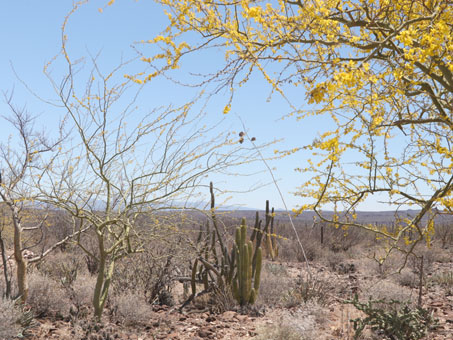
Not long after we reached the top of the Cuesta del Infierno out of Santa Rosalia, we started to see Palo Brea trees (Parkinsonia praecox, Fabaceae) in bloom.
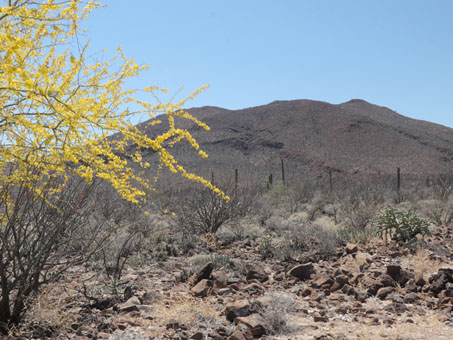
Many appeared as beacons glowing amidst the grayish landscape.
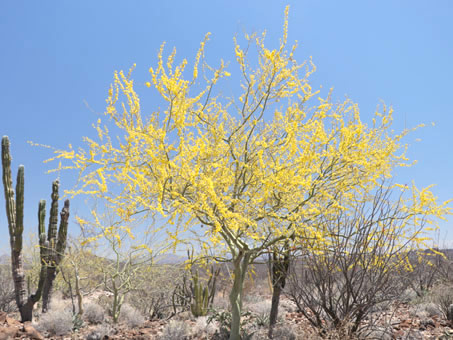
A magnificently glowing Palo Brea (Parkinsonia praecox).
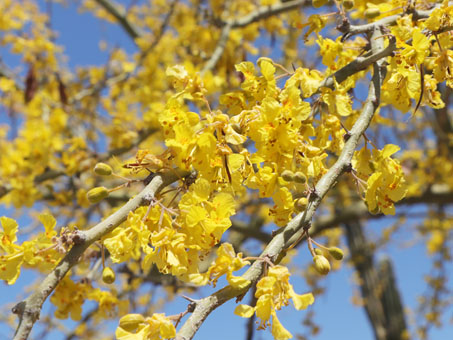
Palo Brea flowers (Parkinsonia praecox).
Km 249 South of Laguna Chapala
This is a favorite spot of mine with an easy pullout. It has a high diversity of species and it's interesting to follow how the area changes with the variation in weather and time of year. This is the third time we've stopped at this spot in the past 2 years but it was one of the first spots I remember stopping at on one of our early Baja trips in the 1990s, when, as previously mentioned, I'd seen the root parasite Desert Broomrape (Aphylon cooperi) for the first time. Compared to our previous visit last May, the area was incredibly dry. In other spots north and south there were a few more signs of Spring, mainly from the Ocotillos and Cardons.
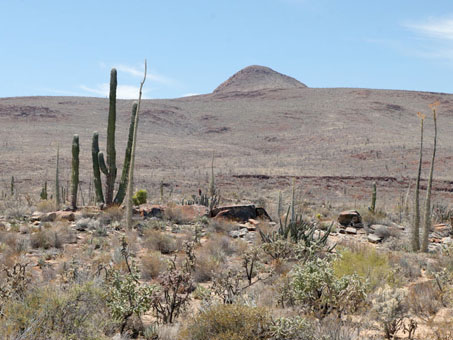
The view looking towards the west from the west side of the highway.
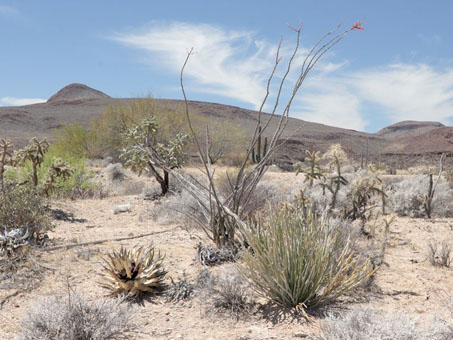
Same direction as the previous photo, but from the east side of the highway. There were a few Ocotillos with some blooms.
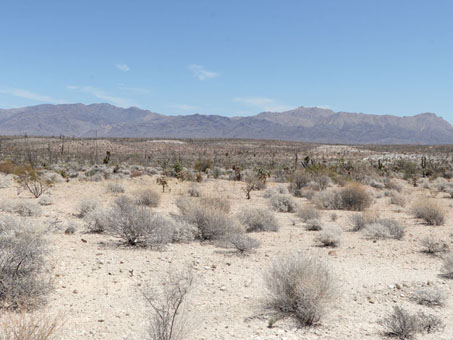
Turning around from the location in the previous photo & now facing east, looking across the desert plain. The glare was blinding.
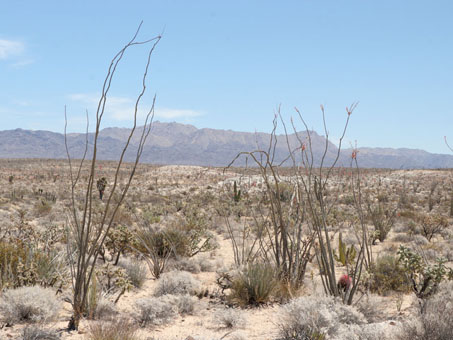
Same direction as previous, from a location farther from the highway.
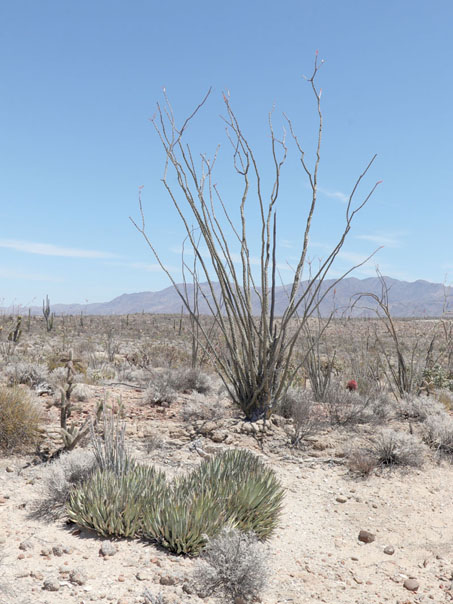
Desert Agave/Mescal (Agave desertii, foreground) with Ocotillo (Fouquieria splendens) behind.
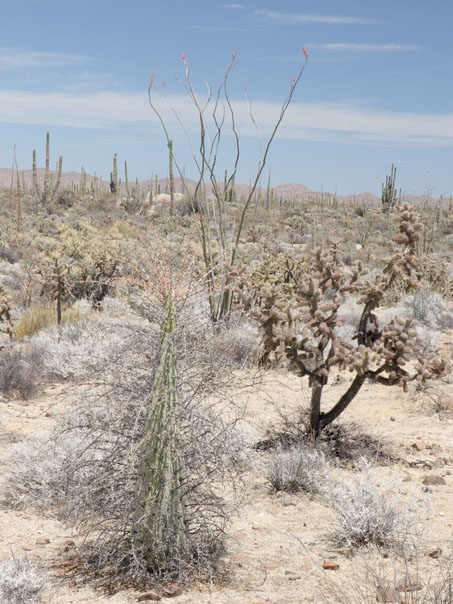
A small Boojum Tree (Fouquieria columnaris, foreground).
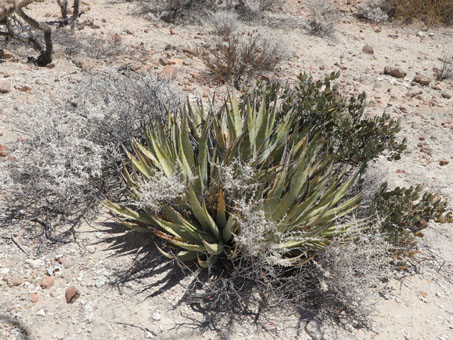
Desert Agave/Mescal or Maguey can grow singularly but most commonly it pups to form a small colony of individual clones. It rarely reproduces from seed. It provides food, moisture, & shelter to wildlife.
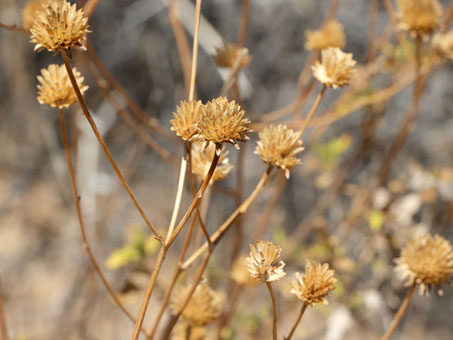
San Diego Sunflower/Flor de mayo (Bahiopsis laciniata, Asteraceae). These are the involucral bracts (paleae) persisting once the flowers and fruit (achenes) have fallen. A few dry leaves with laciniate margins clinched the ID.
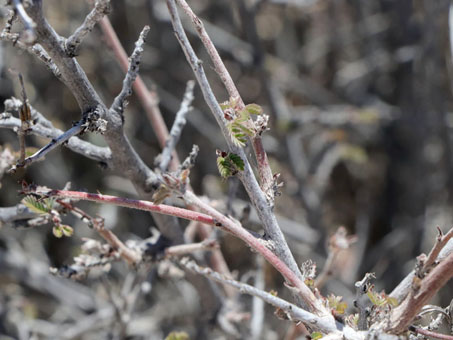
It took me a moment to recognize this shrub. The tiny, new pinnate leaves & the dry remnants of the flower's many feathery stamens gave it away: California Fairyduster-Tabardillo (Calliandra californica, Fabaceae)
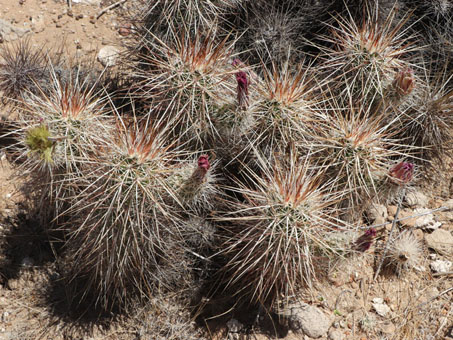
Englemann Hedgehog cactus (Echinocereus engelmannii var. engelmannii). Yet again, I just missed the flowers. In the 20 plus years spent on the peninsula, I have as yet to see any Hedgehog cactus with a fresh, open flower.
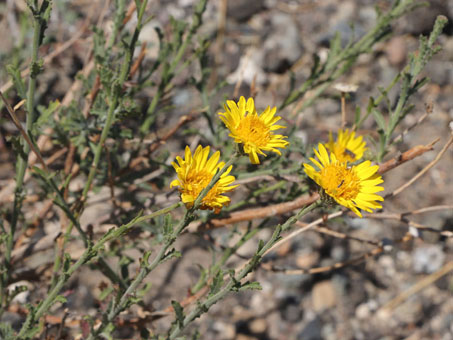
Peninsular Tansy-aster / Cola de Zorra (Xanthisma scabrellum, Asteraceae). This species has been in bloom every visit to this spot.

The stems & hummingbird-pollinated floral structure of Candelilla/Slipper Plant (Euphorbia lomelii, Euphorbiaceae). The bilateral cyathium consists of a single female & several male flowers.
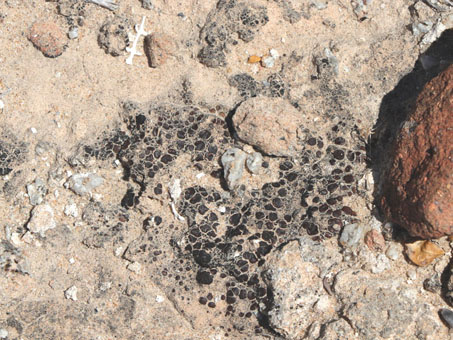
Lichen growing on the dirt. Part of the biological soil crust (BSC).
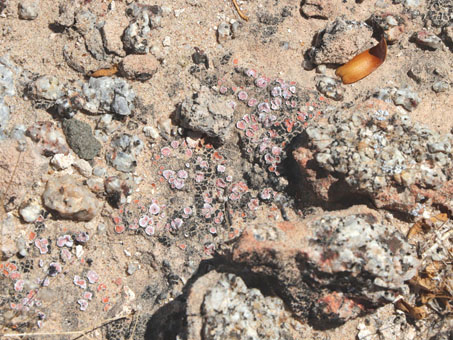
Another BSC lichen growing on the dirt.

This Baja California Nicolletia/Hierba del Venado (Nicolletia trifida, Asteraceae) was growing right at the edge of the pavement where there is a little more available moisture. Flower head c. 2-2.5 cm D.
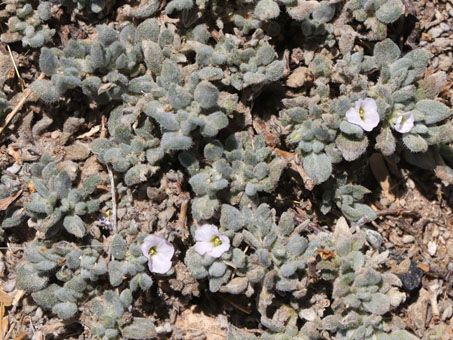
Woody Crinklemat (Tiquilia canescens var. canescens, Ehretiaceae). Flowers are about 5 mm D & the leaves furry.
Hwy 5 - Km 118 Laguna Chapala to Puertecitos
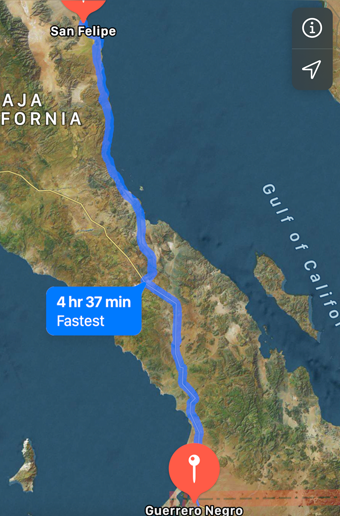 As is so common while driving along the highway in excess of 50 mph, it seems that there is little of interest happening botanically even while the landscape visibly changes on a regular basis. That is until you actually pull over to take a look at something that might actually have caught your eye.
As is so common while driving along the highway in excess of 50 mph, it seems that there is little of interest happening botanically even while the landscape visibly changes on a regular basis. That is until you actually pull over to take a look at something that might actually have caught your eye.
So, true to form, everything was looking fairly uninteresting until suddenly, a small to medium sized shrub covered in pale yellow flowers started to pop up all along the side of the road and in the adjacent arroyos and washes starting a few miles north of El Huerfanito.
However, it took many miles before there was both a plant and a pullout that occured together (driving with a small trailer definitely limits the choices of pullouts). Below are just a few of the other species that we found while investigating the shrub, many of them tiny annuals well hidden in the gravelly, rocky soil.
Image source: OpenStreetMap 2021
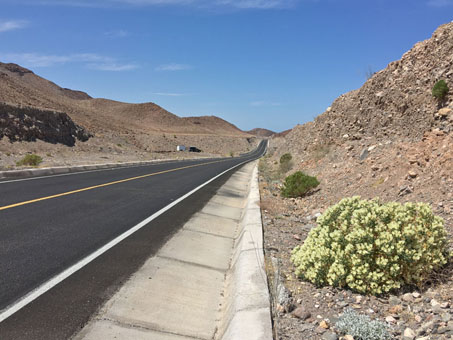
This is what caught our eye initially. Desert Rock-nettle (Eucnide urens, Loasaceae). Urens means burning or inflaming in Latin. The shrub is about 1 m H x D.
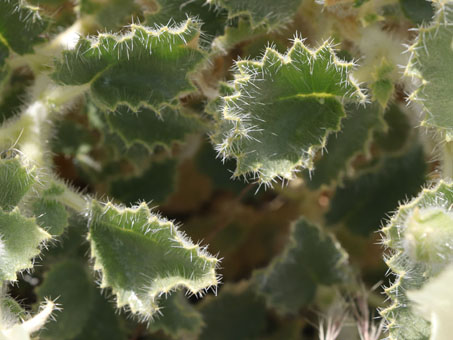
Since I didn't know the identity of this species until later, I didn't dare test how irritating the formidable "stinging" hairs on the leaves of Desert Rock-nettle actually were: they looked scary enough to give me pause at the time.
The plant looked so velvety...but the stinging hairs (trichomes) found on Loasaceae are like hypodermic needles, releasing an irritant when the tip breaks off in the skin [1], [2]. This species is apparently particularly nasty. Illustrationes in Jepson eFlora show that it has a two types of hairs, one straight and needlelike (stinging kind), and the other with grappling hooks along the shaft that act like velcro.
I'm quite familiar with the stinging hairs of E. cordata and E. rupestre from my Mulege studies. I have handled both species with little problem: they only sting a little when the stiff, longer hairs penetrate the skin deeply and then break off, causing more of a mechanical irritant than a chemical one. At least, that's my personal experience. I think my run in with the Tricolor Buck Moth caterpiller (Fire worm translated from Spanish) a few years ago stopped me from touching the plant while getting photos or I'm sure I would have had a very unpleasant trip the rest of the way.

Leaves & flower buds are densely hairy.

All the plants we saw were blooming profusely.
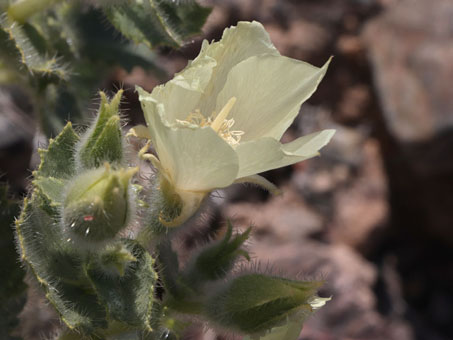
Desert Rock-Nettle flowers with new buds. The cup-shaped flowers are fairly large, 25-30 mm D. Check out that long stigma.
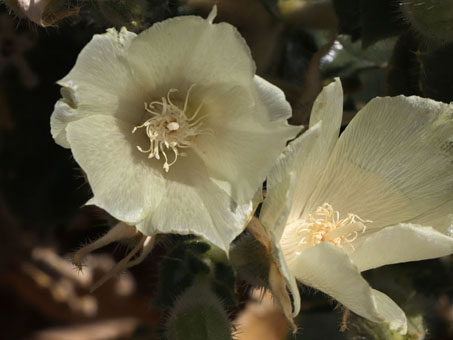
The many stamens form a tube around the style. The 5 petals are cream or pale yellow.
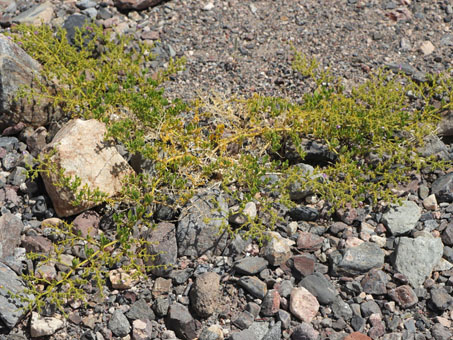
Sticky Fagonia (Fagonia pachyacantha, Zygophyllaceae) is a perennial herb with a woody caudex. Many of these bright green plants were prostrate, though some formed low rounded mounds.
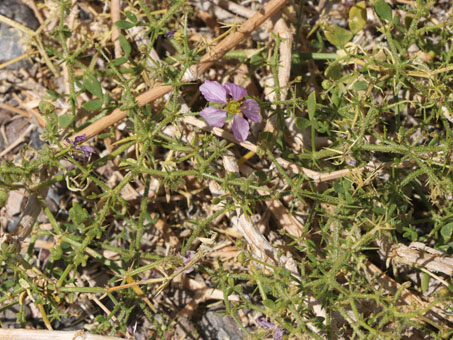
The herbage of Sticky Fagonia is covered with conspicuous stalked- glandular hairs. The 4 spreading stipules are c. 1 cm L and sharp. The leaves of the plants we saw were mostly thickened. The purple flowers are about 15 mm D.
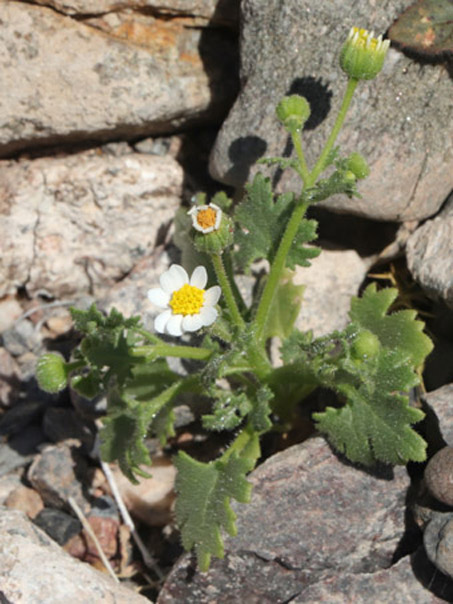
Emory Rock-Daisy (Perityle emoryi, Asteraceae), an annual herb wide-spread on the peninsula. This plant was less than 10 cm H. The flower here was c. 7-10 mm D.
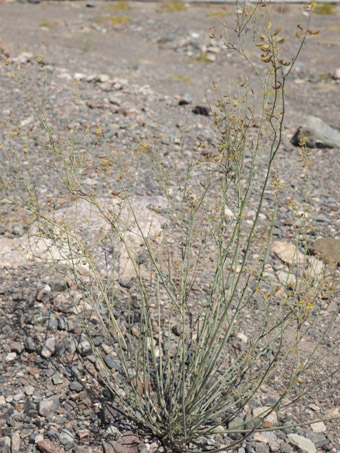
Gulf Rush-Pea (Hoffmannseggia microphylla, Fabaceae) is a peninsular near-endemic found along the Gulf coast from around here & southward supposedly to around Bahía Concepción, though I never came across it during my flora study over 15 field seasons.

Gulf Rush-Pea. Flowers are c. 1-1.5 cm D
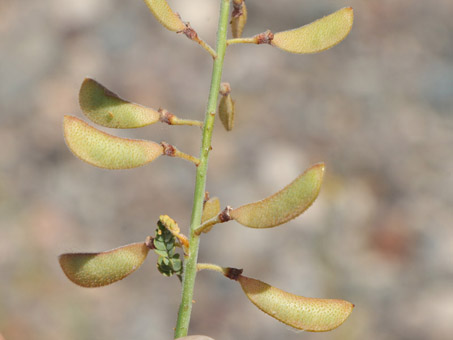
Fruit & a leaf of Gulf Rush-Pea. The compressed pods are c. 2-3 cm L & covered with minute stalked oil glands.
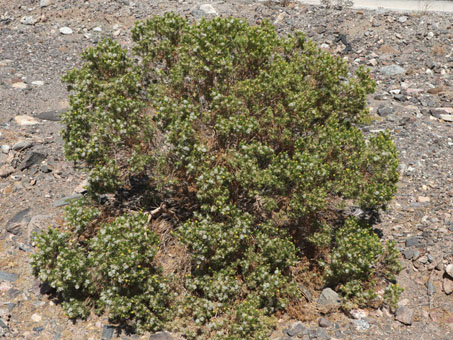
Pygmy-Cedar/Romero del Desierto (Peucephyllum schottii, Asteraceae). At highway speeds, I had a hard time telling this apart from Creosotebush which was also very green and covered with flowers & fruit.
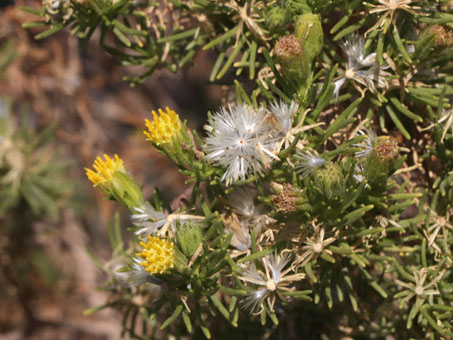
Last year we encountereed this species in this same region but this is the first time we saw it in bloom. The linear, resin-coated leaves are 1-2 cm L. The discoid flower heads contain 12-21 florets & are 1-1.5 cm D.
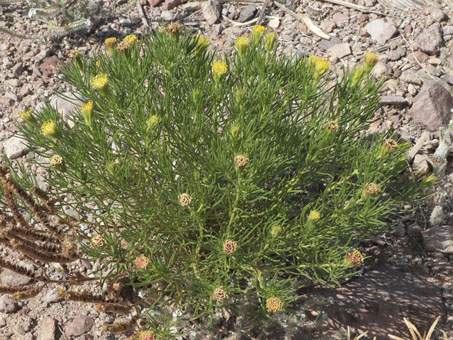
A young Pygmy-Cedar plant, about 40 cm H x D.
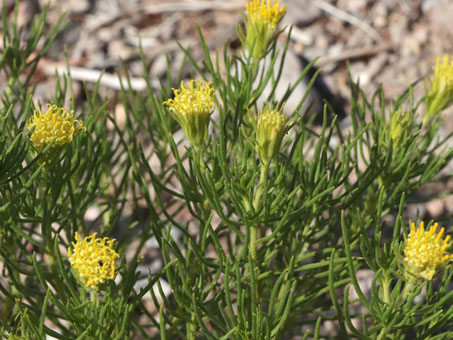
Leaves & flowers of the young Pygmy-Cedar.
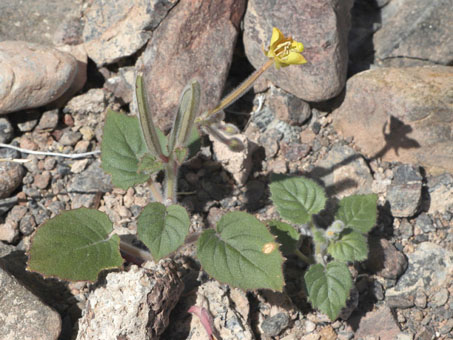
Heart-Leaf Suncup (Chylismia cardiophylla, Onagraceae). The entire plant was less than 10 cm H. Flowers here were less than 1 cm D.
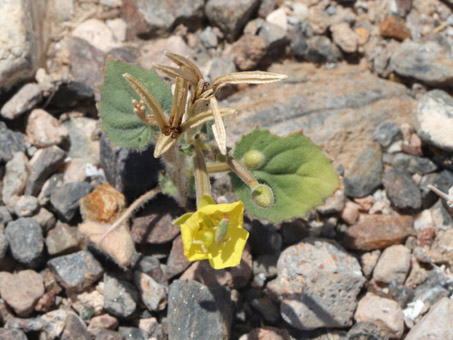
Heart-Leaf Suncup. This specimen 5 cm H had two old fruit, a flower & two buds! What determination to reproduce.
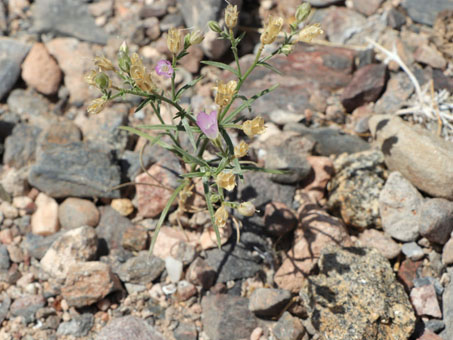
Palmer Bryantiella (Bryantiella palmeri, Polemoniaceae) leaves, flower, & dry capsules. This endemic annual stands c. 15 cm H.
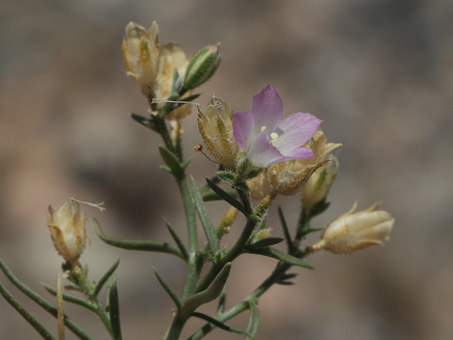
Palmer Bryantiella. There were dozens of tiny plants that, at this stage of development, practically disappeared into the gravelly background.
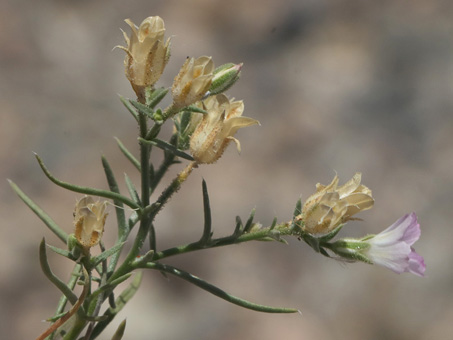
Palmer Bryantiella. Flowers were c. 10-15 mm L.
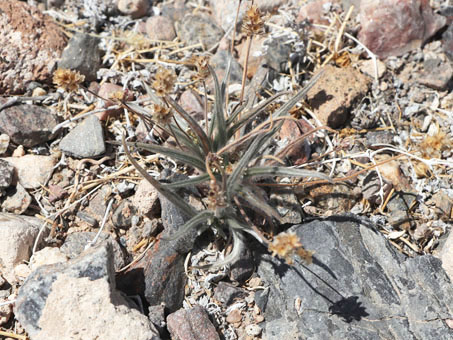
Wooly Plantain/Pastora (Plantago ovata, Plantaginaceae). Another tiny annual c. 5 cm H.
Hwy 5 - Km 38 N of Puertecitos
Before each stop we´d made along the route so far, I´d kept saying to myself, "just one more stop...". But of course, there would be another interesting plant or area to check out, so out of the car we´d get. A short distance south of Puertecitos, Lupines and other flowering herbs started popping up in dense stands at the edge of the highway. Oh boy, another chance!
It was already getting late in the day, we were tired, and of course, it took awhile to find a good place to pull over. But we hit the jackpot again when we were finally able to get off the road. There were were lots of flowers at roadside and in the disturbed soils 20-30 yards from the road.
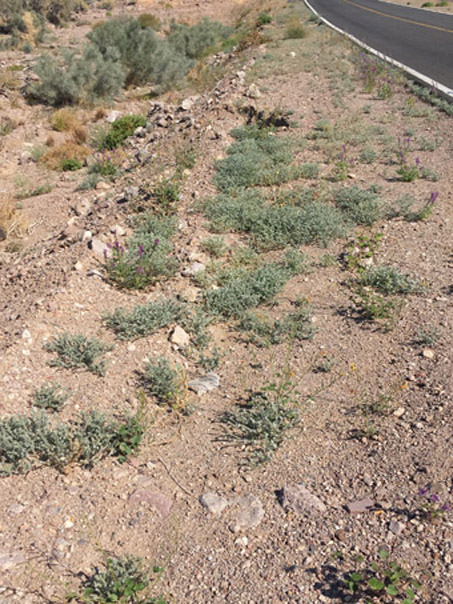
Some of the plants at the edge of the highway south of Puertecitos.
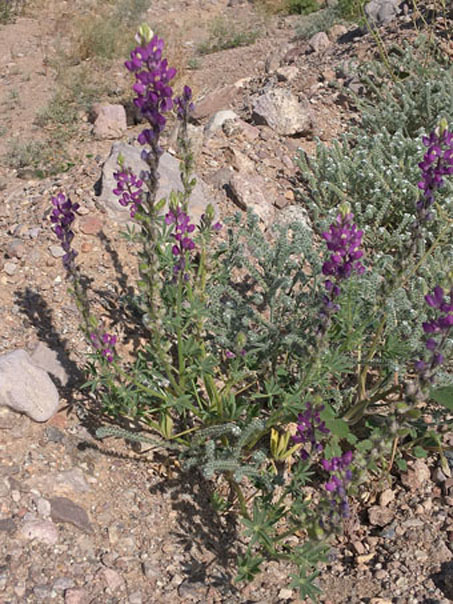
The most dominant were Narrow-Leaf Cryptanthas (Johnstonella angustifolia) & Arizona Lupines (Lupinus arizonicus).
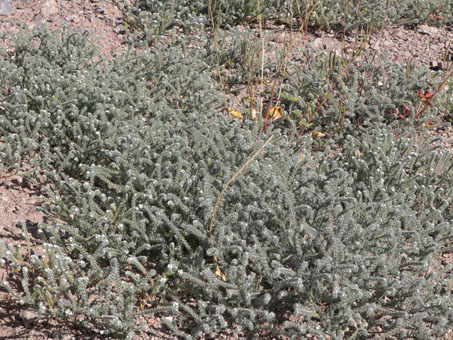
Just one of hundreds of dense patches of Narrowleaf Cryptantha carpeting the ground.
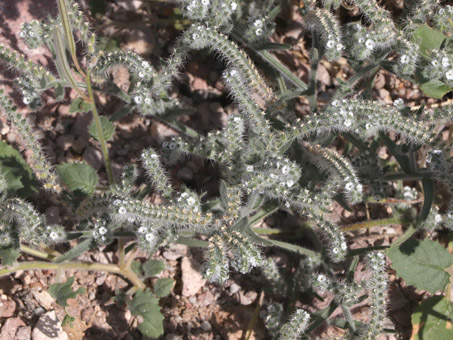
Closeup of the inflorescences of Narrowleaf Cryptantha & the leaves of Heart-leaf Suncup. The corollas are c. 2 mm D.
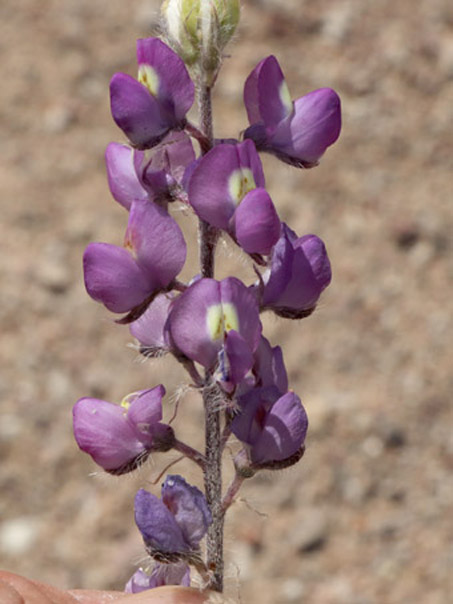
Arizona Lupine (Lupinus arizonicus, Fabaceae) is a highly variable species.
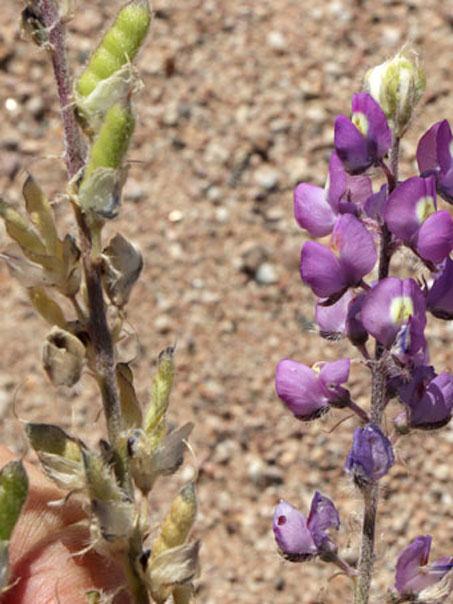
Arizona Lupine can be found from near Mexicali to the Cape region, including some of the peninsula´s islands.
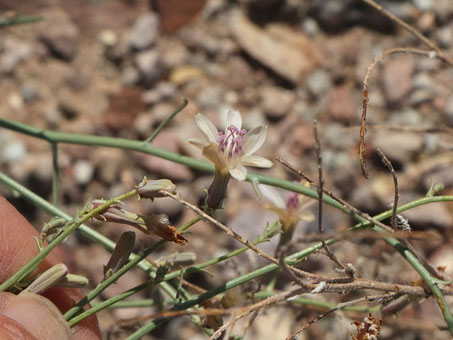
Not sure which species of Wire-Lettuce (Stephanomeria sp., Asteraceae) this is. It was a small bushy herb, likely a perennial. There are at least two possible taxa for the region. All Stephanomerias are natives & two of the nine taxa found on the peninsula are endemic.

Baja California Groundcherry (Physalis crassifolia var. infundibularis, Solanaceae) is a near-endemic found on the north eastern side of the peninsula. We saw this for the first time earlier this year with lots of flowers. Most plants now had more fruit than flowers. See more in April's entry.
That´s quite a lot for this month. Next time, I´ll finish our northward trip with a few more of the plants we saw on the final leg of our trip south of the border. So, until then, hasta pronto...
Debra Valov—Curatorial Volunteer
References
[1] Mustafa, A., Ensikat, H. J., & Weigend, M. (2017). Ontogeny and the process of biomineralization in the trichomes of Loasaceae. American journal of botany, 104(3), 367–378. https://doi.org/10.3732/ajb.1600417 [Accessed 6-Jun-2021] [back to text]
[2] Mustafa, A., Ensikat, H. J., & Weigend, M. (2018). Stinging hair morphology and wall biomineralization across five plant families: Conserved morphology versus divergent cell wall composition. American journal of botany, 105(7), 1109–1122. https://doi.org/10.1002/ajb2.1136 [Accessed 6-Jun-2021] [back to text]
Rebman, J. P., J. Gibson, and K. Rich, 2016. Annotated checklist of the vascular plants of Baja California, Mexico. Proceedings of the San Diego Society of Natural History, No. 45, 15 November 2016. San Diego Natural History Museum, San Diego, CA. Full text available online.
Rebman, J. P and Roberts, N. C. (2012). Baja California Plant Field Guide. San Diego, CA: Sunbelt Publications. Descriptions and distribution.
Turner, R. M., J.E. Bowers & T.L. Burgess (2005). Sonoran Desert Plants: An Ecological Atlas. Tucson: University of Arizona Press. Descriptions, natural history.
Valov, D. (2020). An Annotated Checklist of the Vascular Plants of Mulegé, Baja California, Mexico. Madroño 67(3), 115-160, (23 December 2020). https://doi.org/10.3120/0024-9637-67.3.115
Wiggins, I. L. (1980). The Flora of Baja California. Stanford University Press. Keys and descriptions.





















































